The Bugatti Tourbillon
The Bugatti Tourbillon is the latest creation from the Bugatti Atelier in Molsheim, France. It is a perfect marriage of a high-revving 8.3-liter naturally aspirated V16 engine and three electric motors.
 Photo by Bugatti Automobiles S.A.S.
Photo by Bugatti Automobiles S.A.S.
In 2004, the reborn Bugatti brand transformed the world of automotive performance and luxury with a 1,001 hp hyper sports car: the Veyron. The first road car with more than 1,000 hp was succeeded in 2016 by another engineering feat so ambitious it reset all expectations of performance, the world's first 1,500 hp car: the Chiron. At the heart of these cars was the world's most advanced automotive engine: an 8.0-liter quad-turbo W16. Now, 20 years after Bugatti invented the hyper sports car, the concept of the hyper sports car has been redefined completely with an entirely new powertrain and platform. This is the Bugatti Tourbillon.
As with every Bugatti of the modern era, the Tourbillon is "shaped by speed." The ability to travel at more than 400 km/h requires every single surface, inlet, and ridge to be finely honed to ensure it is not only aerodynamic but also beneficial to the car's thermodynamics. This is the guiding principle of the Tourbillon, which then evolved around four Bugatti design elements inspired by history: the horseshoe grille, the Bugatti Line, the central ridge, and the dual color split.
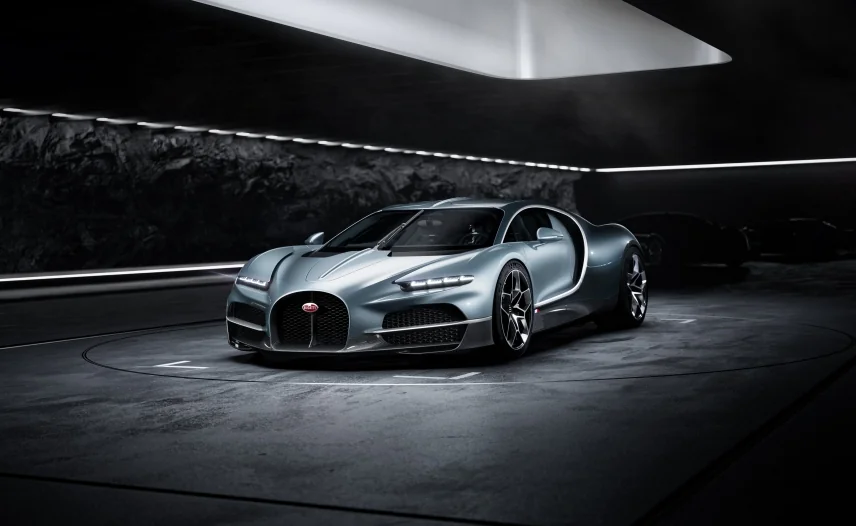
Although beautiful in its design and proportions, every surface, intake and vent is carefully honed to balance the enormous aerodynamic forces of a car travelling at over 400 km/h as well as the thermodynamic requirements of a V16 engine, electric motors and battery at full performance.
Using over 20 years of expertise from the Veyron and Chiron, the Tourbillon features a number of patented technologies. As a result, the rear wing even remains submerged during top speed runs, with a perfect equilibrium of forces generated by these new innovations. The wing is utilized to establish higher downforce at slower speeds and as an airbrake for improved stability under deceleration.
Much of this aerodynamic equilibrium is thanks to the new diffuser concept, which starts to climb from just behind the passenger cabin, rising at an ideal angle to keep the Tourbillon in perfect balance. The diffuser is built around a completely new crash concept, which is fully integrated within the structure of the diffuser itself, keeping it both enormously effective but also hidden from sight, enabling the open rear-end design.
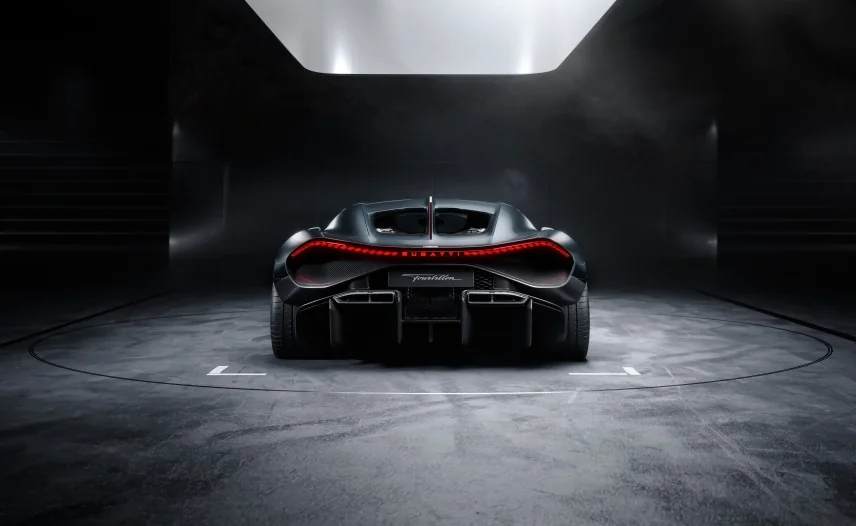
At the heart of the Tourbillon's design ethos is the iconic horseshoe, from which all lines of the car originate, shaping the central fuselage volume. Docked onto that left and right are the flying fenders that allow to stream air underneath the headlights to boost air mass flow into the side intakes. This intricate interplay of airflow is further exemplified by the frontal design, which, while maintaining the dimensions of a sculpted overhang, ingeniously houses an ultra-efficient cooling system that directs air through and out of the front bonnet, augmenting downforce while ingeniously packaging a sizable frunk in between the two radiators.
A set of advanced, electrically actuated dihedral doors not only allow for easy entry into the vehicle but provide a dramatic sense of arrival, able to be opened and closed from the key fob, the door opening button found just underneath the Bugatti Line and on the center console.
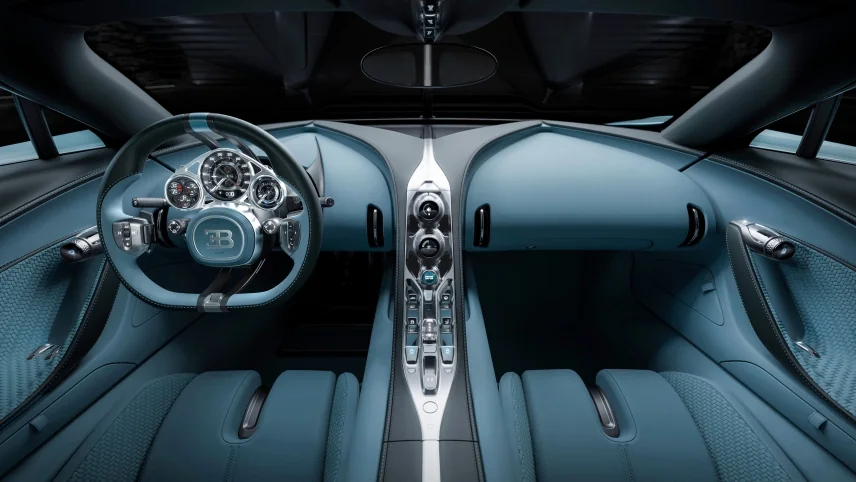
The Interior
Ever since car manufacturers began to embrace digital screens and touchscreens in cars, the rate of progress has been so rapid that the technology appears outdated within less than a decade. Imagining the Tourbillon on concours d'elegance lawns not just in 10 years but perhaps in 100 years, the design philosophy of the interior focused on timelessness. Inspired by the world of horology, in which wristwatches over 100 years old can still be worn and used today, integrated seamlessly into modern fashion and lifestyles, the design and engineering teams pioneered an authentic analog experience in the cabin.
The centerpiece of this takes the horologie philosophy to its most literal conclusion: an instrument cluster designed and built with the expertise of Swiss watchmakers. Made up of more than 600 parts and constructed from titanium as well as gemstones such as sapphire and ruby, the skeletonized cluster is built to the largest tolerance of 50 microns, with the smallest at 5 microns, and weighs just 700g. This intricately engineered masterpiece remains a focal point of the driving experience, fixed in place as the steering wheel's rim rotates around it - a set-up known as a fixed hub steering wheel. Through this ingenious concept, Tourbillon drivers have an unobstructed view of their instrumentation independent of the steering angle because the spokes reach around the back of the instrument cluster.
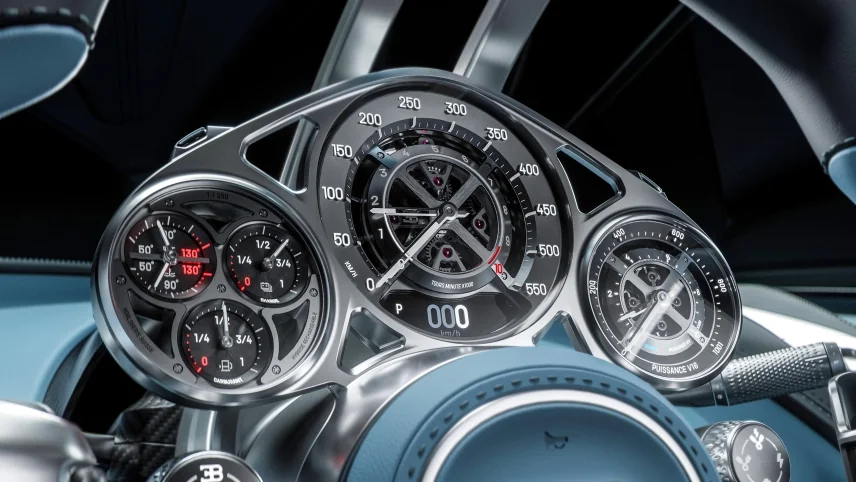
The center console is a blend of crystal glass and aluminum, revealing the intricate workings of the switches and the engine start pull lever that it hosts. This glass was developed over 13 separate stages to ensure it was both perfectly clear and extremely strong, and safe in the event of an accident. The aluminum parts of the console are anodized and milled from a single block of metal, while the knurled aluminum switches sit at the head of a complex mechanism that is fully visible beneath the crystal glass - entirely developed in-house. The act of igniting the all-new naturally aspirated V16 engine and electric powertrain has been crafted to be a physical experience, a nod to the rituals of historic automobiles - a pull to start and a push to cease.
But hidden from view until desired is a high-definition digital screen, which displays vehicle data and offers a seamless mobile connection. An intricately engineered mechanism deploys the touchscreen from the top of the center console; portrait mode for the reversing camera in just two seconds and full landscape mode in five seconds.
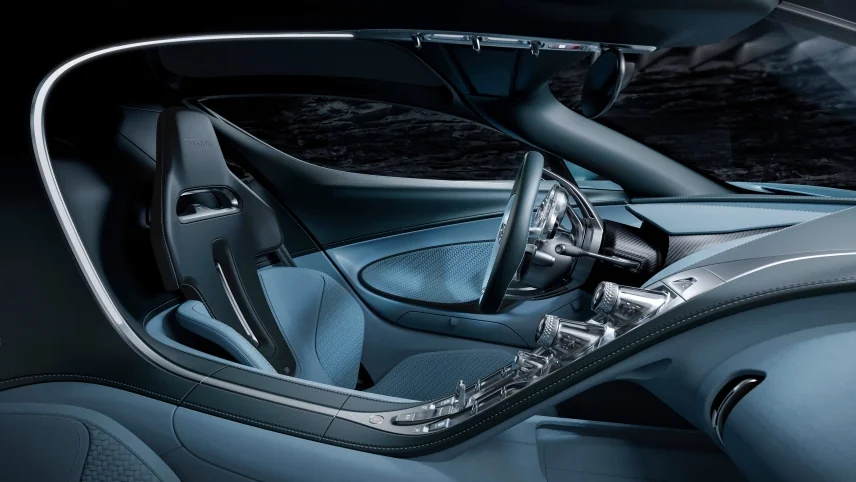
Every interior decision - just as it is with the exterior - is made with ultimate performance in mind, without compromising in any way on practicality or comfort. The seats, for example, are fixed to the floor to be as light and as low as they can possibly be, and the pedal box can be electrically adjusted forward and backward to ensure a comfortable driving position for everyone. This new solution makes the interior spacious, making it ideal for longer trips and daily use. Even the audio system is being engineered without traditional speakers and woofers, so an advanced system that features exciters on the door panels and throughout the car is being opted for, using existing interior panels as speakers. It is a lighter and more efficient system than traditional audio setups.

The Powertrain and Performance
The Bugatti W16 engine was unlike any other automotive engine in the world when it was revealed. With its four turbos and prodigious power figures, it set a new benchmark for the limits of combustion engine technology, and two decades after its creation it's still unmatched or replicated. Following in its footsteps is another incomparable masterpiece of internal combustion engineering, paired with the immediate torque and flexibility of electric motors.
This next-generation Bugatti hyper sports car is powered by an all-new 8.3-liter naturally aspirated V16 engine - engineered with the help of Cosworth - paired with a front e-Axle with two electric motors and one electric motor mounted at the rear axle. In total, the Tourbillon produces 1,800 hp with 1,000 from the combustion engine itself and 800 hp from the electric motors. It's an extraordinary achievement - delivered thanks to a host of cutting-edge materials and technology - given the Veyron achieved 1,001 hp from its 8.0-liter capacity engine with four turbochargers, and the new V16 is completely naturally aspirated. Constructed from lightweight materials, the engine weighs just 252 kg.
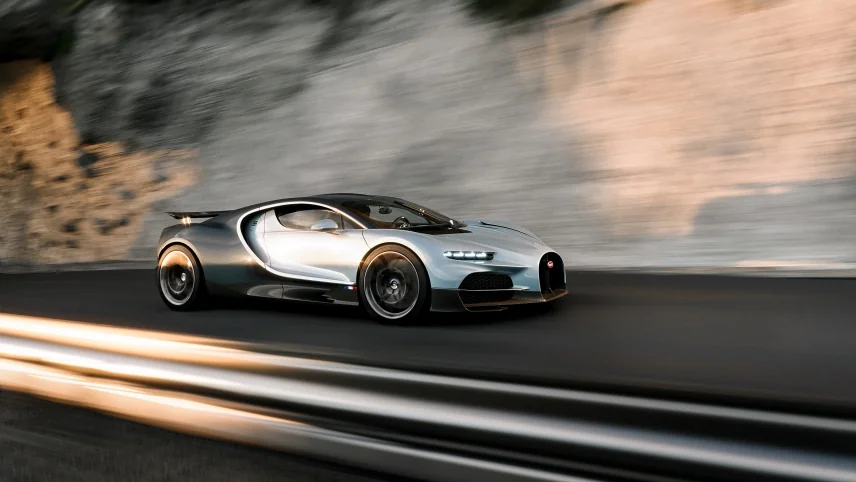
The electric motors are powered by a 25 kWh oil-cooled 800V battery housed in the central tunnel and behind the passengers. With four-wheel-drive and full torque-vectoring, it offers ultimate traction and agility. The front e-axle houses two electric motors, with a further motor on the rear axle, for a total of 800 hp from the electric powertrain system. The electric powertrain, with the electric motors spinning up to 24,000 RPM and a fully integrated dual silicon-carbide inverter, is amongst the most power-dense in the world. The e-axles are delivering over 6 kW per kg of e-axle mass, including inverters, motors and gearboxes. While power, throttle response, and torque-fill are priorities for the electric powertrain, the relatively large energy content of 25 kWh allows for a very usable all-electric range of more than 60 km / 37 miles.
In the automotive industry, each new model is expected to be heavier than its predecessor. Especially if the new model adds a hybrid powertrain or requires more performance, but with a new Bugatti, the unexpected should be the norm. The Tourbillon boasts significantly improved performance, a very powerful electric powertrain system, and a large battery pack, and yet, it weighs less than the Chiron, which is a testament to the incredible engineering behind the Tourbillon. The Bugatti Tourbillon delivers extraordinary performance with its lightweight construction and instantaneous torque from the electric motors.
Thanks to the combination of an extremely advanced hybrid powertrain, lightweight engineering, efficient packaging, and advanced aerodynamics, the Tourbillon will significantly reduce emissions compared to its predecessor while still enhancing the driving experience and bringing the pinnacle of the automotive industry to new levels.
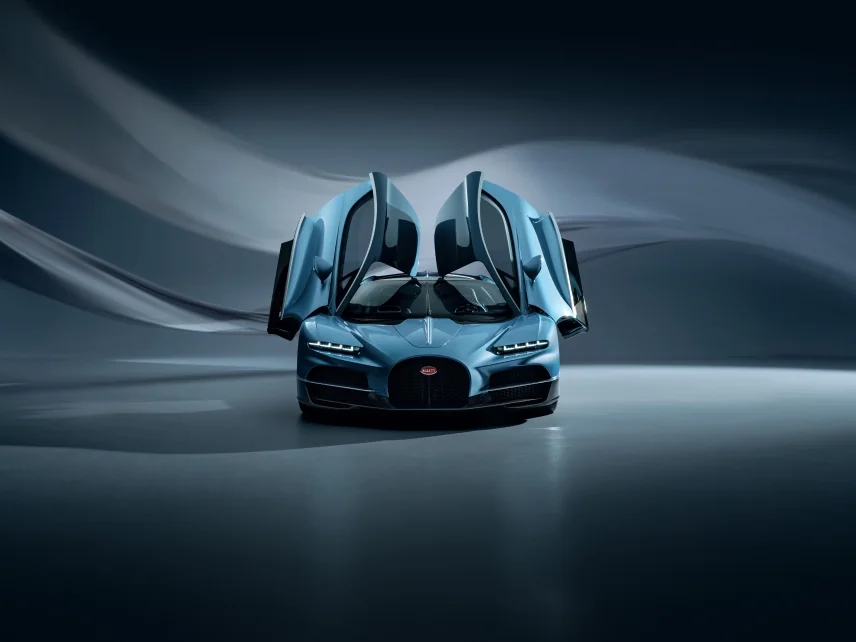
The Engineering
The Tourbillon is designed around an entirely new chassis and body structure. The structure is made from a next-generation T800 carbon composite, which incorporates a number of weight-saving innovations, such as integrating the battery as a structural part of the monocoque and an unprecedented crash composite rear diffuser inspired by top-level motorsport. The front composite air ducts that flow through the front of the car are also integral to the structure, ensuring that each and every part of the rigid, lightweight structure is optimized. For example, the front and rear frames exhibit low-pressure thin wall aluminum casting and 3D-printed structural braces, contributing to a structure that is significantly lighter and stiffer than its predecessor!
The completely new chassis integrates multi-link suspension front and rear, forged from aluminum, moving on from the double wishbone steel construction found in the Chiron. By opting for a new organic-designed suspension arm and upright, 3D-printed aluminum, engineers have saved 45% in suspension weight compared with the Chiron. The rear also features an AI-developed 3D-printed hollow airfoil arm to enhance vehicle dynamics and aerodynamic performance.
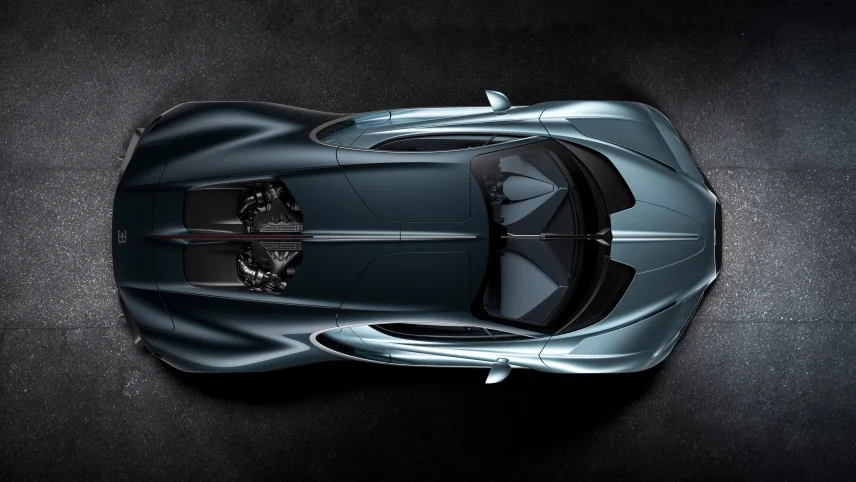
The brakes are equally advanced, featuring the ultimate carboceramic technology. A bespoke brake-by-wire system is introduced, fully integrated with the moveable pedal box, and blended seamlessly through an integrated vehicle non-linear controller developed by Bugatti to the hybrid powertrain. Michelin Pilot Cup Sport 2 tires - 285/35 R20 at the front and 345/30 R21 at the rear - are a bespoke development for the Tourbillon.
Within the new chassis, the new ultra-compact and lightweight front e-axle with dual independent motors, including the dual-inverter, fits within the same package space that was available in Chiron, adding more complexity without requiring more space. Designers and engineers also freed up more storage space and a more significant luggage component as part of the clean-sheet chassis and bodyshell design, allowing owners to fit a set of bespoke Bugatti Tourbillon luggage.
The Bugatti Tourbillon now enters its testing phase, with prototypes already on the road in anticipation of customer deliveries in 2026. A total of 250 examples will be built, with a starting price of 3.8 million EUR net. Hand assembly will take place at the Bugatti Atelier in Molsheim, following the final W16-powered Bugatti models, Bolide and W16 Mistral.
Find more Cars
Bugatti W16 Mistral
The legendary story of Bugatti is as much one of arete art and elegance par...
The McLaren 650S Sprint
Based on the recently launched McLaren 650S Coupe, the track-focused 650S S...
Coffee Run with Deadmau5 - Episode 3
The third episode of Deadmau5 and friends on a Coffee Run. This episode fea...
The new Audi R8
A high-revving mid-engine with superior performance, a consistently lightwe...
Audi RS 3 Sportback
With the most powerful production five-cylinder in the world, outstanding d...
McLaren 720S Spider
The new McLaren 720S Spider is the most accomplished convertible supercar e...




















